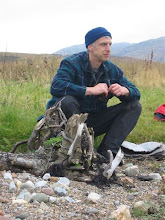





Another bitterly cold but stunningly beautiful morning on Flanders Moss, no snow but more hawfrost than you could shake a stick at. I was out for a quick check around the boardwalk and tower to see if all is OK before meeting up with 3 members of the Scottish Raptor group. Kestrels were on our mind and with good reason. Back in the 1970s when I was a boy kestrels were the commonest British bird of prey and as a child one of the few pleasure to be found in a long motorway trip was spotting kestrels every few miles hovering over the rough grass motorway edges. However during the 1980s the population dropped dramatically most likely due to the effects of the lethal pesticides that accumulated in their prey. The population has recovered a bit since then but hear in Scotland there is a particular concern as since the mid 1990s the population have been dropping fast. Places like the Carse of Stirling used to hold a significant number of pairs but can you remember when you last saw a kestrel hovering ? At Flanders Moss we still seen them because unlike the surrounding intensively farmed land Flanders still has rough grass areas that can hold good populations of small mama ls and insects like beetles that they mostly eat. But the kestrels still need help so the plan is to help the Scottish Raptor group put up a few nest boxes for safe nesting sites. These will also allow the group to keep an eye of how successful the breeding pairs are and this information is vital if the decline in these birds is to be halted. The poet Ted Hughes in The Hawk in the Rain (even though he called it a hawk rather than correctly a falcon) beautifully captured the sight of a kestrel and what a shame it would be if the next generation couldn't experience it.
"Effortlessly at height hangs his still eye / His wings hold all creation in weightless quiet / Steady as hallucination in the streaming air / While banging wind kills those stubborn hedges" (Ted Hughes, The Hawk in the Rain)
